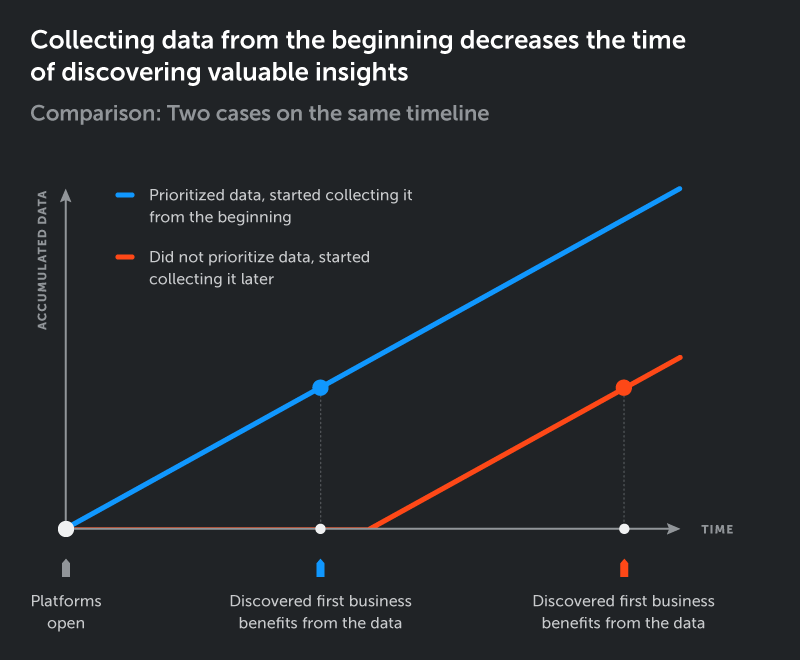Why most L&D data initiatives fail and what you can do to stop it
L&D professionals realize the potential benefits of utilizing learning data, but it is also seen as complicated, overwhelming, and a burden to implement.

If you work in Learning and Development, you already know that data and learning analytics are hot topics right now and they are not just buzzwords; data and learning analytics have significant benefits and the potential to strengthen L&D as a strategic business unit within organisations.
Despite the benefits, we often see these data initiatives fail.
Common barriers preventing successful data initiatives
L&D professionals realize the potential benefits of utilizing learning data, but it is also seen as complicated, overwhelming, and a burden to implement. In many cases, data initiatives do not move forward because they do not bring the desired results or they end up being small scale pilot projects without any long-term strategic benefits.
We have spotted the four most common barriers for implementing a successful learning data initiative.
1. The knowledge barrier
As data utilisation is still relatively new for many organizations and experts, the beginning feels complex and time consuming. In other words, it is hard to know where to even begin with your data.
2. The organisational barrier
Data initiatives require cross-organisational collaboration and communication.
For example, it is important to involve IT to discuss data security and data availability. Initiating these discussions with different organisational stakeholders can be very difficult and time-consuming to get everyone on the same page, especially when the concept of data utilisation is new to everyone.
3. The metrics barrier
It takes scrupulous consideration to define the most important metrics, KPIs and analytics that would yield the desired business benefits.
Especially when the knowledge of data is not deep enough. Once again, this requires cross-organisational communication.
4. Solutions Fatigue
Finally, there is the issue of solutions fatigue. There are many solutions involved in collecting data and analytics.
You may have multiple learning platforms, an LRS solution, and multiple other systems that can provide you with insight. Connecting all the systems together, in order to create a big picture of how your learning initiatives are affecting your business outcomes, can be cumbersome.
If you can’t measure it, you can’t improve it.
– Peter Drucker
The solution: start collecting your data first
We have learned that the best way to overcome the challenges listed above, is to begin with collecting your learning data. In practise, this means implementing a solution to collect rich learning data using industry standards. The current definitive standard for collecting data is xAPI, and the Learning Record Store (LRS) is used to store the data from the learning platform.
By taking one big step forward by focusing on collecting your data, you will reap three major benefits:
1. Build your foundation
In order to be data-driven, you need to start collecting your data.
Once you are collecting the data, the knowledge barrier lowers. First, you will start seeing simple visual insights from the data, getting familiar with it. Soon enough you and your colleagues will understand the potential learning data holds in your organisation.
Collecting the data also helps with cross-organisational discussions. You will be able to use learning data as evidence to back your arguments, and present the benefits.
When you start collecting the data, be sure to choose a standardised data collection tool. That way you can later pick any solution to process and analyze the data.
2. Don’t lose vital learning data
Your KPIs and business objectives may change over time, and most likely they will change due to the changing landscape of business. Don’t waste time waiting to develop your KPIs when you can be collecting your learning data.
By beginning to collect your learning data right away, you will have more insight into how learning can be used to affect any KPI you may choose. If you take too much time to develop the perfect KPIs, and then start collecting the data, you most likely have lost a lot of useful learning data.
3. The fast lane to business benefits
If you collect learning data from the beginning, you can start analysing as soon as possible, but over time, as your data accumulates, your insights from the data will also grow. 
Example customer story: start with data, end with business benefits
Valamis uses the out-of-the box LRS solution in learning solution implementations, so in any case the data collection starts the first day of implementation.
With one of our customers in the governmental sector this paid off in a big way. The customers’ original intention was to use the learning data only for statistical uses – to report annual platform adoption rates and training completions.
As the data started to accumulate, new ideas for analytics started to emerge. In addition to annual reporting, the learning data was used to make data-driven decisions for developing the digital learning offering and for improving learner engagement. Whenever a question arose, we could turn to the collected data for answers.
In one instance, a large annual training offering with an estimated 10,000+ participants was improved with learning data. By tracking the learner journeys, we could pinpoint which parts of the training were the most time consuming and where learners were having issues with the content.
We then visited a similar type of learning content that was working and delivering results, and evaluated why it worked better. Based on our findings, we made changes to the content that did not work that well and managed to reduce the time it took to complete the training by two hours.
When doing the calculations, a two hour reduction on the completion times, meant over 20,000 hours saved for 10,000+ learners.
The key takeaway is that even though this organization did not know what they could do with the data from the beginning, they collected the data and then acted on the insight gained from all of the data.




